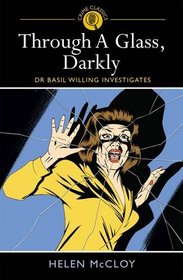Through a Glass, Darkly by Helen McCloy
Review by Matt B. (BuffaloSavage)
This 1949 mystery starts in cozy way, with shy young art teacher Faustina Crayle living and working in a girl’s boarding school that is prim to the point of grim. Like Rebecca at Manderley, she’s being given poor service on top of the fisheye by the servants. Faustina’s problem is the fallout from multiple witnesses seeing her double here and there on school grounds
You enter a room, a street, a country road. You see a figure ahead of you, solid, three-dimensional, brightly colored. Moving and obeying all the laws of optics. Its clothing and posture is vaguely familiar. You hurry toward the figure for a closer view. It turns its head and – you are looking at yourself. Or rather a perfect mirror-image of yourself only – there is no mirror. So, you know it is your double. And that frightens you, for tradition tells you that he who sees his own double is about to die…
One professional challenge caused by this uncanny phenomenon is that she is fired from her job. One of her fellow teachers, a pretty refugee Austrian named Gisela von Hohenems, urges her fiancé to look into the “termination without cause.” Her fiancé is psychiatrist Dr. Basil Willing, on staff of a famous Big Apple hospital and consultant to the NYC DA.
Since its first publication, this mystery has received much acclaim for its skillful use of a superstitious belief about The Double as a background for an outstanding mystery plot (see also Dorothy L. Sayers’ “The Image in the Mirror”). McCloy seems to have known a little about a range of people, places, and phenomena. She includes informational tidbits about costume designs for the production of the play Medea, changes in kitchens over time in the Western world, and shifts of attitude on the sable vs. mink controversy. Like Edith Wharton, McCloy provides plenty of details about room arrangements, furnishings, furniture and colors of wall paints. Into describing clothes in a big way, McCloy sent me to my thread-bending wife to ask about words like “chiffon” and “taffeta” and “voile.”
From the early Thirties to the late Seventies, critics and readers respected McCloy for her elegant writing. Even when the reader is dubious about seemingly supernatural elements in a mystery, McCloy’s solution can also appeal to readers who are skeptical about the paranormal. It’s a challenging balance but she manages it through intelligent and graceful writing that is beyond our expectations for a mystery.


